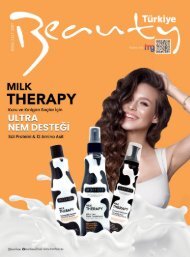You also want an ePaper? Increase the reach of your titles
YUMPU automatically turns print PDFs into web optimized ePapers that Google loves.
78<br />
HTE<br />
EVENTS<br />
Probably the first product to meet this challenge was (and<br />
still is) marketed as Gore-Tex® for outdoor clothing. Gore-<br />
Tex®, however, is not a coated fabric, but a waterproof,<br />
breathable membrane that has been laminated.<br />
The availability of water vapor permeable polyurethane<br />
dispersions also allowed direct coating on the inside of<br />
the fabric. This is where roller knife coatings are applied.<br />
Depending on the required stress, stable foam coatings<br />
and also paste coatings are used.<br />
Lamination<br />
Lamination is generally understood to be the joining together<br />
of two or more layers of textile, film, membrane<br />
or fleece and to keep the layers together an adhesive is<br />
needed, which can be applied by either coating or screen<br />
printing.<br />
A distinction can be made here between dry or wet lamination.<br />
In wet lamination, the adhesive is initially applied<br />
to the first layer and the second layer is then placed in<br />
the wet application before the two materials are dried and<br />
fixed together.<br />
The disadvantage of this process is the hardness/rigidity<br />
of the laminated end product. In dry lamination, the adhesive<br />
is applied to the first material and dried and the<br />
second layer is then applied to it via high pressures, usually<br />
by a calender. A special case is that of stable foam<br />
lamination.<br />
In this process, a layer of foam is applied by a roller doctor<br />
blade and carefully dried. The second layer is then<br />
placed into the dry foam by a crush calender. Afterwards,<br />
however, this laminate must still be thermally fixed. Foam<br />
lamination has the softest touch and in the case of polyurethane<br />
foam the laminate is also thermally resistant, as<br />
the adhesive is not thermoplastic after fixing.<br />
Conclusion<br />
In this article I have tried to provide an overview of the<br />
technology of textile coating and would like to conclude<br />
by listing just some of the coated materials that are to be<br />
encountered in daily routines.<br />
We can start with the mattress cover, slippers, the shower<br />
curtain and the bathmat and move through to the dining<br />
table with its coated tablecloth, then out to the hallway<br />
for a rain jacket and umbrella. In the car, countless more<br />
coated fabrics are to be found, from the seat cover to the<br />
trunk, and just as many coated materials will be encountered<br />
by commuters using trains or buses.<br />
<strong>Textile</strong> coating is still a technology of the future with which<br />
money can still be made. With the increase of lightweight<br />
construction, just as one example, fibre reinforced materials<br />
are becoming increasingly important. Here, textiles or<br />
fibre scrims are only used to reinforce the plastic matrix,<br />
but the technology of production is similar and therefore<br />
represents another growth area for textile coating.<br />
<strong>February</strong> <strong>2022</strong>

















